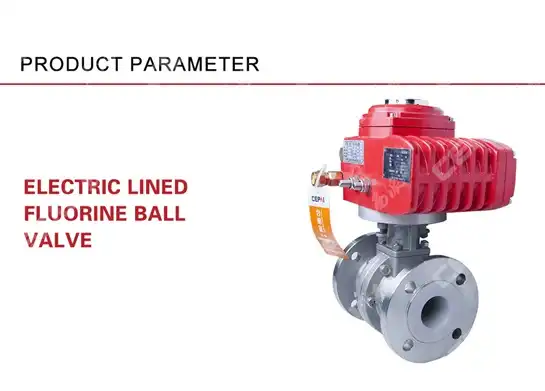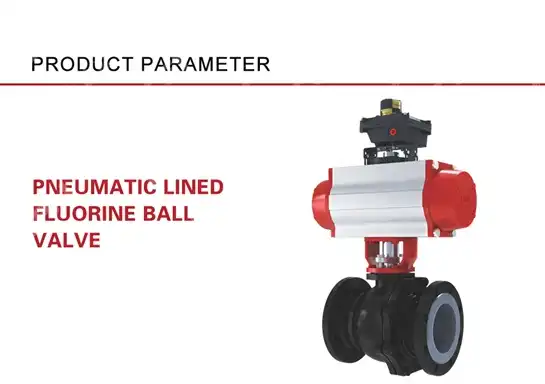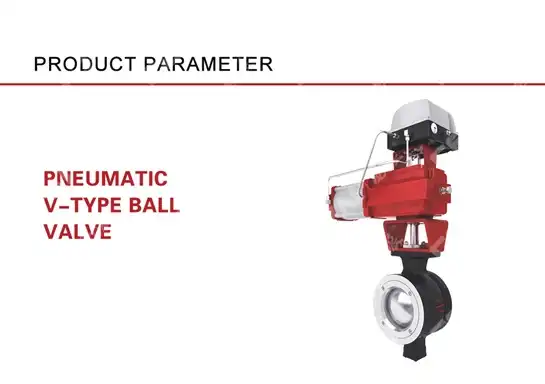Cast Steel Pneumatic V-Shaped Ball Valve: Working Principle Explained
Industrial process engineers face constant challenges with flow control systems that struggle with viscous fluids, pulp slurries, and media containing solid particles. Traditional ball valves often fail to provide precise modulation while maintaining tight shut-off capabilities in these demanding applications. The Cast Steel Pneumatic V-Shaped Ball Valve emerges as a critical solution, combining robust cast steel construction with pneumatic actuation and a distinctive V-shaped port design that delivers exceptional control performance across diverse industrial environments where conventional valves simply cannot meet operational requirements.
Understanding the Cast Steel Pneumatic V-Shaped Ball Valve Architecture
The Cast Steel Pneumatic V-Shaped Ball Valve represents an advanced evolution in flow control technology, engineered specifically to address the limitations of standard ball valve designs. Unlike conventional ball valves with circular ports, this specialized valve features a precisely machined V-notch geometry cut into the spherical ball element. The cast steel body provides exceptional structural integrity, enabling the valve to withstand high pressure applications typically found in petrochemical processing, power generation, and oil and gas production facilities. The pneumatic actuation system utilizes compressed air to drive the valve between open and closed positions, offering rapid response times and reliable operation in hazardous environments where electrical systems pose safety concerns. The fundamental architecture integrates several critical components working in harmonious coordination. The valve body, manufactured from high-quality cast steel alloys, serves as the primary pressure boundary and houses all internal components. Material selection typically involves carbon steel grades or stainless steel variants depending on the corrosive nature of the process media. The spherical ball element contains the distinctive V-shaped port profile, which creates a characterized flow curve enabling precise throttling control. As the ball rotates through its operating range, the progressively opening V-notch provides linear or equal percentage flow characteristics, making the Cast Steel Pneumatic V-Shaped Ball Valve ideal for modulating control applications requiring accurate flow adjustment.

-
Material Selection and Construction Standards
Cast steel construction offers significant advantages over fabricated alternatives in valve manufacturing. The casting process allows for complex internal geometries while maintaining uniform material properties throughout the valve body. For the Cast Steel Pneumatic V-Shaped Ball Valve, manufacturers typically employ ASTM A216 WCB carbon steel or ASTM A351 CF8M stainless steel, depending on temperature and corrosion requirements. These materials exhibit excellent mechanical properties including high tensile strength, superior impact resistance, and reliable performance across wide temperature ranges. The casting process also eliminates weld seams that could become potential failure points under cyclic loading or thermal stress conditions. The internal components undergo rigorous heat treatment processes to optimize hardness and wear resistance. The V-shaped ball element receives specialized surface treatments such as nitriding or hard chrome plating to extend service life when handling abrasive media. Seat rings manufactured from reinforced PTFE or metal-seated designs provide reliable sealing performance. The Cast Steel Pneumatic V-Shaped Ball Valve design incorporates replaceable seat assemblies, enabling maintenance without removing the valve from the pipeline. This serviceability feature significantly reduces lifetime ownership costs while maintaining process continuity in critical applications.
-
Pneumatic Actuation System Integration
The pneumatic actuator converts compressed air energy into rotational torque required to operate the Cast Steel Pneumatic V-Shaped Ball Valve. Modern pneumatic actuators employ rack-and-pinion or scotch-yoke mechanisms that deliver high torque output with compact dimensions. The actuator mounts directly to the valve stem using ISO 5211 mounting patterns, ensuring interchangeability across different manufacturers. Air supply pressures typically range from 4 to 7 bar, generating sufficient torque to overcome stem friction and seat sealing forces during valve operation. Control systems configure pneumatic actuators in either double-acting or spring-return configurations. Double-acting designs require air pressure for both opening and closing strokes, providing positive control in both directions. Spring-return actuators incorporate internal springs that automatically drive the valve to a predetermined fail-safe position upon loss of air supply. This fail-safe capability proves essential in emergency shutdown applications where process safety demands reliable valve closure. The Cast Steel Pneumatic V-Shaped Ball Valve can integrate with positioners that precisely control ball position in response to electrical control signals, enabling sophisticated process control strategies.
Working Principle of the V-Shaped Port Design
The distinctive V-shaped port geometry fundamentally differentiates this valve from standard ball valve designs. In conventional ball valves with circular ports, flow area increases rapidly during initial opening, creating highly nonlinear flow characteristics unsuitable for throttling control. The V-notch profile in the Cast Steel Pneumatic V-Shaped Ball Valve provides controlled flow area increase proportional to valve rotation angle. This engineered flow characteristic enables precise flow modulation throughout the valve's operating range, from minimal flow at nearly closed positions through maximum flow at full opening. As compressed air enters the pneumatic actuator, the internal piston or vane mechanism converts pressure energy into rotational motion. This rotation transmits through the actuator output shaft to the valve stem, which connects directly to the spherical ball element. The ball rotates within the valve body, with the V-shaped notch gradually aligning with the flow path. At closed position, the solid portion of the ball contacts the seat rings, creating a tight shut-off that prevents flow passage. During opening rotation, the V-notch begins intersecting the flow stream, initially allowing minimal flow through the narrow portion of the V-profile. Continued rotation exposes progressively larger portions of the V-notch to the flow stream, increasing flow capacity in a controlled manner until reaching full open position at 90-degree rotation.

-
Flow Characteristics and Control Performance
The V-shaped port geometry creates characterized flow curves that dramatically improve control valve performance compared to standard ball valves. Engineering the V-notch angle and profile shape allows manufacturers to tailor flow characteristics to specific application requirements. Equal percentage characteristics, where flow rate changes by a constant percentage for equal increments of valve travel, suit applications with varying pressure drops. Linear characteristics, providing constant flow change per unit of valve travel, prove advantageous when maintaining consistent pressure drop across the Cast Steel Pneumatic V-Shaped Ball Valve throughout its operating range. The shearing action between the V-shaped ball and seat rings provides self-cleaning capabilities essential for handling difficult media. Fibrous materials, suspended solids, and viscous fluids that would plug conventional control valves pass through the Cast Steel Pneumatic V-Shaped Ball Valve with minimal accumulation. The V-notch edge acts like a knife blade, cutting through fibrous material and preventing buildup that could impair valve operation. This characteristic makes V-port ball valves preferred choices in pulp and paper processing, wastewater treatment, mining slurry handling, and other applications involving non-clean fluids.
-
Sealing Technology and Leakage Prevention
Achieving reliable sealing performance presents unique challenges in rotary ball valve designs, particularly when incorporating V-shaped ports for control applications. The Cast Steel Pneumatic V-Shaped Ball Valve employs advanced sealing technologies that maintain tight shut-off while accommodating the thermal expansion, pressure-induced deformation, and wear occurring during extended service. Seat ring designs utilize spring-loaded or pressure-energized configurations that maintain constant contact force between the ball surface and seat regardless of operating conditions. This ensures leak-tight performance meeting or exceeding industry standards such as ANSI FCI 70-2 for control valve seat leakage. Stem sealing systems prevent process fluid leakage to the atmosphere, critical for handling hazardous or toxic materials. Multi-stage packing arrangements incorporating PTFE, graphite, or other specialized packing materials provide reliable stem sealing across wide temperature ranges. Live-loaded packing glands maintain optimal compression on packing materials, compensating for thermal cycling and packing consolidation during service. The Cast Steel Pneumatic V-Shaped Ball Valve design allows packing adjustment or replacement under pressure using specialized tooling, enabling maintenance without process shutdown. Auxiliary sealing options including lantern rings for flush injection or secondary stem seals for fugitive emission control accommodate stringent environmental regulations.
Application Advantages in Industrial Process Control
The Cast Steel Pneumatic V-Shaped Ball Valve delivers exceptional performance across diverse industrial applications where conventional control valves struggle. In petrochemical refineries, these valves handle catalyst slurries, polymer melts, and high-temperature hydrocarbon streams requiring both tight shut-off and precise flow control. The robust cast steel construction withstands erosive service conditions while the V-port design prevents plugging from suspended catalyst particles. Power generation facilities employ these valves in circulating water systems, ash handling circuits, and flue gas desulfurization processes where reliability directly impacts plant availability. Oil and gas production operations utilize the Cast Steel Pneumatic V-Shaped Ball Valve extensively in wellhead control, gathering systems, and processing facilities. The valve's ability to handle dirty service conditions with sand production, scale formation, and paraffin deposition makes it invaluable in upstream applications. Rapid shut-off capabilities provided by pneumatic actuation enable emergency isolation, protecting personnel and equipment during upset conditions. The quarter-turn operation minimizes actuator size compared to linear-motion control valves, reducing topside weight in offshore platform installations where space and weight constraints drive equipment selection.
-
Performance in Severe Service Conditions
Severe service applications characterized by high pressure drops, cavitation, flashing, or noise generation demand specialized valve designs. The Cast Steel Pneumatic V-Shaped Ball Valve addresses these challenges through optimized trim designs that control energy dissipation. Multi-stage pressure reduction achieved through stacked V-port configurations or anti-cavitation trim attenuators prevents the damaging effects of vapor bubble collapse. Material upgrades including hardened seat rings, stellite-faced balls, and heavy-wall body constructions extend service life in erosive applications. Temperature extremes from cryogenic to high-temperature service require careful material selection and design considerations. The Cast Steel Pneumatic V-Shaped Ball Valve accommodates cryogenic applications down to minus 196 degrees Celsius using specialized materials and extended bonnet designs that prevent actuator freezing. High-temperature applications up to 540 degrees Celsius utilize elevated-temperature cast steel alloys with graphite packing systems and cooling fins on extended stems. Thermal expansion compensation through belleville spring assemblies in the seat retention system maintains sealing performance throughout thermal cycling.
-
Maintenance and Lifecycle Cost Optimization
Maintenance accessibility significantly impacts total cost of ownership for industrial valves. The Cast Steel Pneumatic V-Shaped Ball Valve incorporates design features that simplify maintenance and extend service intervals. Top-entry body designs allow complete trim removal without disturbing pipeline connections, enabling in-situ maintenance that reduces turnaround duration and expense. Modular trim designs with interchangeable components standardize spare parts inventories across multiple valve sizes, optimizing inventory investment while ensuring parts availability. Predictive maintenance strategies leverage condition monitoring technologies integrated with modern pneumatic actuation systems. Smart positioners with diagnostic capabilities track valve performance parameters including stem travel, actuator pressure, control signal response, and cycling frequency. Trending these parameters identifies developing problems before failure occurs, enabling planned maintenance during scheduled outages rather than emergency repairs during production. The Cast Steel Pneumatic V-Shaped Ball Valve reliability combined with predictive maintenance reduces unplanned downtime and extends mean time between failures compared to alternative control valve technologies.
Installation, Commissioning and Operational Considerations
Proper installation practices ensure the Cast Steel Pneumatic V-Shaped Ball Valve achieves design performance throughout its service life. Pipeline support must account for valve weight and actuator loads, preventing excessive stress on body connections. Orientation typically positions the actuator vertically above the valve body, protecting electrical components from process fluid leakage. However, mounting flexibility allows horizontal or inverted installations when space constraints dictate alternative configurations. Maintaining specified clearances around the actuator enables maintenance access and proper heat dissipation. Commissioning procedures verify proper valve operation before introducing process fluids. Stroke testing confirms full valve travel between closed and open positions, checking for binding or interference throughout the rotation range. Timing tests measure stroke duration, ensuring pneumatic actuation meets process requirements for emergency shutdown or control response. Leak testing at maximum allowable pressure verifies seat sealing integrity and identifies body or bonnet leakage requiring correction. Control loop tuning optimizes positioner parameters to achieve stable control without hunting or oscillation that could reduce trim life. Operational best practices maximize the Cast Steel Pneumatic V-Shaped Ball Valve performance and longevity. Avoiding prolonged operation at near-closed positions prevents erosive damage from high-velocity flow through minimal openings. Regular exercising of isolation valves that remain stationary for extended periods prevents seat adhesion and packing friction increase. Monitoring process conditions for erosion, corrosion, or fouling indicators enables timely maintenance intervention before significant degradation occurs. Documentation of operating hours, cycle counts, and maintenance activities supports reliability analysis and parts forecasting for planned maintenance programs.
Conclusion
The Cast Steel Pneumatic V-Shaped Ball Valve provides superior control and reliability in demanding industrial processes. Its unique V-notch geometry, robust cast steel construction, and responsive pneumatic actuation deliver precise flow modulation while maintaining excellent shut-off performance even with challenging media containing solids and fibers.
Cooperate with CEPAI Group Co., LTD.
Partner with CEPAI Group Co., LTD., a China Cast Steel Pneumatic V-Shaped Ball Valve manufacturer with ISO 9001, API 6A, and CE certifications. As a leading China Cast Steel Pneumatic V-Shaped Ball Valve supplier, CEPAI operates from a 56,000-square-meter intelligent manufacturing facility featuring Asia-Pacific's longest high-precision production line. Our China Cast Steel Pneumatic V-Shaped Ball Valve factory combines advanced engineering with competitive Cast Steel Pneumatic V-Shaped Ball Valve price points. We offer China Cast Steel Pneumatic V-Shaped Ball Valve wholesale solutions and High Quality Cast Steel Pneumatic V-Shaped Ball Valve for sale backed by comprehensive technical support and remote AR maintenance guidance. Request your customized quote today at cepai@cepai.com to discover how CEPAI's proven reliability serves PetroChina, Sinopec, and global energy leaders. Bookmark this guide for reference when specifying your next valve procurement.
References
1. Emerson Process Management. "Control Valve Handbook: Fourth Edition." Fisher Controls International LLC. Technical Documentation Series.
2. American Petroleum Institute. "API Standard 6D: Specification for Pipeline and Piping Valves." API Publishing Services. Latest Edition.
3. International Society of Automation. "ANSI/ISA-75.01.01: Industrial-Process Control Valves - Part 2-1: Flow Capacity - Sizing Equations for Fluid Flow Under Installed Conditions." ISA Standards and Practices Department.
4. Lyons, Jerry L. "The Valve Designer's Handbook." CRC Press. Mechanical Engineering Series, Professional Engineering Edition.
_1746598563385.webp)
Get professional pre-sales technical consultation and valve selection services, customized solution services.

About CEPAI


